2. 福建医科大学孟超肝胆医院药学部, 福建 福州 350025;
3. 福建医科大学孟超肝胆医院重症医学科, 福建 福州 350025;
4. 福建医科大学孟超肝胆医院检验科, 福建 福州 350025
2. Department of Pharmacy, Mengchao Hepatobiliary Hospital of Fujian Medical University, Fuzhou 350025, China;
3. Department of Critical Care Medicine, Mengchao Hepatobiliary Hospital of Fujian Medical University, Fuzhou 350025, China;
4. Department of Laboratory Medicine, Mengchao Hepatobiliary Hospital of Fujian Medical University, Fuzhou 350025, China
重症社区获得性肺炎(severe community-acquired pneumonia, SCAP)是呼吸道严重感染性疾病,病情重,进展快,是脓毒症和感染相关死亡的主要原因[1]。国家早期预警评分(National Early Warning Score, NEWS)是世界上最常用的早期预警评分(EWS)之一,然而有研究[2]报道改良的早期预警评分(MEWS)、NEWS并不能准确预测脓毒症病死率,因此,2017年英国皇家内科医师协会升级NEWS为国家早期预警评分2(NEWS2),以便及早评估急性疾病死亡风险[3]。NEWS2评分在严重临床恶化事件发生前数小时开始呈上升趋势[4],可用于预测急诊环境中危重患者短期死亡风险[5-6],也用于住院患者,如预测严重脓毒症、新型冠状病毒感染、脑肿瘤术后患者的不良预后[7-9],然而,其预后价值并未达成共识[7-8, 10],且在SCAP患者中报道极少见。血乳酸水平升高与SCAP预后差有关[11]。NEWS2评分联合动脉血乳酸预测SCAP患者短期死亡风险目前尚无相关研究报道。本研究回顾性分析97例SCAP患者入院时NEWS2评分情况及血乳酸水平,评估其预测患者预后的价值。
1 对象与方法 1.1 研究对象筛选2017年5月—2022年5月福建医科大学孟超肝胆医院收治的SCAP患者,对其临床资料进行分析。SCAP诊断符合中国成人社区获得性肺炎(CAP)指南[12]相关诊断标准。本研究经过医院伦理委员会批准。纳入标准:①确诊为SCAP;②年龄≥18周岁;③住院时间≥24 h,且资料完整者。排除标准:①肺癌、非感染性间质性肺病、肺水肿、肺栓塞患者;②肺结核或非结核分枝杆菌感染患者;③医疗护理相关性肺炎、医院获得性肺炎病例;④艾滋病患者;⑤入院8 h内未检测动脉血乳酸的患者。
1.2 研究方法 1.2.1 资料收集收集入组患者的吸烟史、饮酒史、基础疾病史(脑血管病、糖尿病、冠心病、高血压病)、性别、年龄、有创机械通气、合并脓毒性休克等医疗资料;采用入院后24 h内急性生理学与慢性健康状况评分Ⅱ(acute physiology and chronic health evaluation Ⅱ,APACHE Ⅱ)评估病情。入院后用药前抽取静脉血进行实验室检测。收集入院当日血常规[白细胞计数(WBC)、血红蛋白(Hb)、淋巴细胞计数(LYM)、中性粒细胞计数(NEU)、血小板计数(PLT)]、降钙素原(PCT)、生化[清蛋白(ALB)、丙氨酸氨基转移酶(ALT)、血糖、肌酐],血气分析[pH值、动脉血氧分压(PaO2)、碳酸氢根(HCO3-)、氧合指数(PaO2/FiO2)、乳酸]、T淋巴细胞亚群(CD3+ CD4+及CD3+ CD8+)等指标,并计算中性粒细胞与淋巴细胞比值(NLR),NLR=NEU/LYM。患者入院8 h内抽取1 mL动脉血,选用GEM Premier 3000分析仪进行血气分析,采用电极法测定动脉血乳酸水平。采集观察指标:患者入院后即予多功能心电监测(GE Dash 4000监护仪),记录入院时脉率、呼吸频率、血压、脉氧饱和度、体温、意识等指标及是否需要吸氧,按NEWS2评分标准[9]进行评分,并将各项得分相加计算出总分,最高20分。其中意识状态采用快速意识状态评分系统(ACVPU),体温为腋下温度。
1.2.2 预后以首次诊断SCAP为研究起点,以第28天或患者死亡为研究终点,随访后依据患者28天预后分为存活组和死亡组。
1.3 统计学方法应用SPSS 26.0统计软件完成相关数据的统计分析,GraphPad Prism 9.3.1进行绘图。计数资料以例数和百分率表示,采用χ2检验进行比较;非正态分布者用中位数及四分位数[M(P25,P75)]表示,采用Mann-Whitney U检验;正态分布的计量资料以均数±标准差表示,采用t检验;采用Spearman相关性分析;采用二元logistic回归分析SCAP患者28天预后的危险因素。采用MedCalc 20.0统计软件中Z检验比较不同指标的曲线下面积(AUC)。采用受试者工作特征(ROC)曲线确定预测指标的评估价值。P≤0.05为差异具有统计学意义。
2 结果 2.1 两组患者一般资料和外周血指标比较本研究纳入符合标准且临床资料完整的SCAP患者97例,女性41例(42.27%),男性56例(57.73%),男女比例为1.37 ∶1,平均年龄(70.68±10.14)岁。随访28天死亡32例(32.99%),存活65例(67.01%)。两组患者的年龄、性别、吸烟史、饮酒史、基础疾病、有创机械通气、脓毒性休克分布情况比较,差异无统计学意义(均P>0.05)。与存活组比较,死亡组患者NEWS2评分、APACHE Ⅱ评分较高,差异有统计学意义(均P<0.001);与存活组比较,死亡组患者的PCT、NLR及血乳酸均明显升高,CD3+ CD4+T淋巴细胞、氧合指数明显降低,差异有统计学意义(均P<0.05);两组患者ALB、WBC、Hb、NEU、ALT等指标比较,差异均无统计学意义(均P>0.05)。见表 1。
| 表 1 存活组与死亡组SCAP患者一般资料和外周血指标比较 Table 1 Comparison of general data and peripheral blood indicators between SCAP patients in survival group and death group |
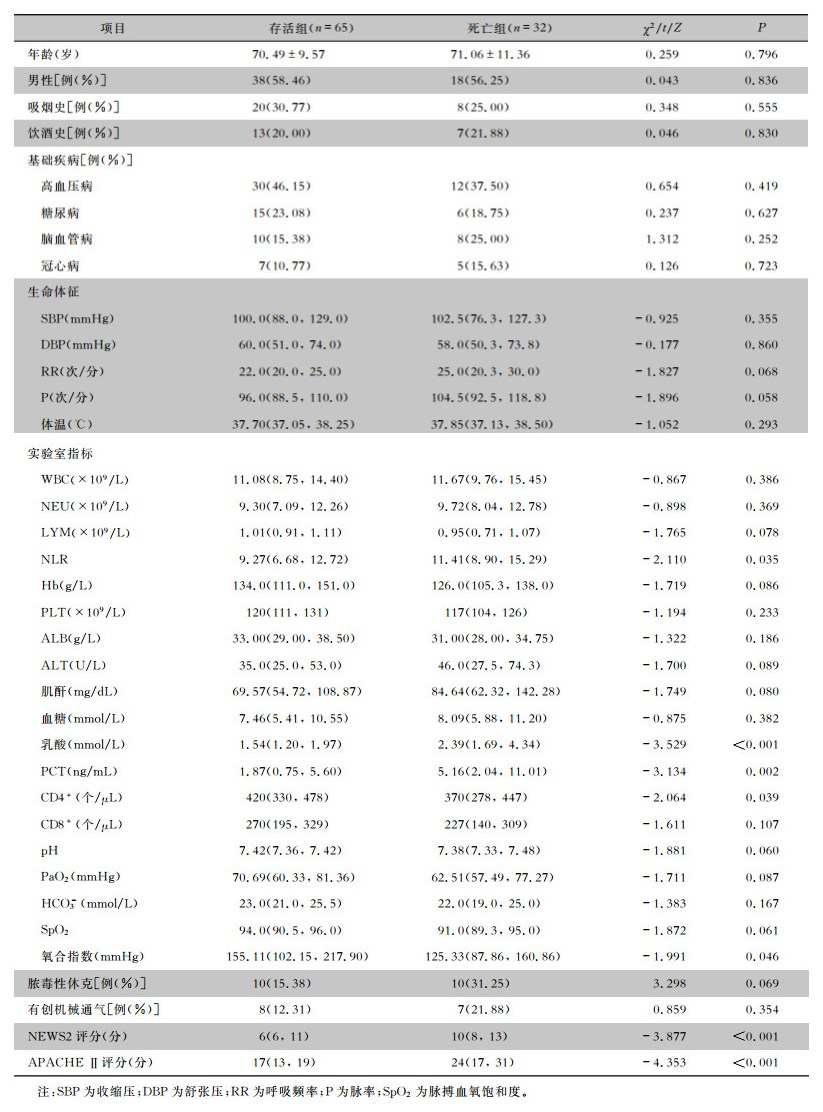
|
Spearman相关性分析结果显示,SCAP患者血乳酸与NEWS2评分呈正相关(r=0.411,P<0.001),血乳酸与APACHE Ⅱ评分呈正相关(r=0.709,P<0.001),且|r|<0.8,为中度相关。见图 1。
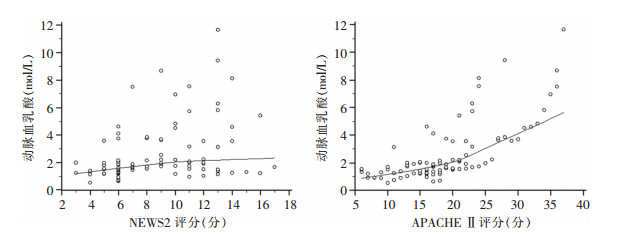 |
| 图 1 血乳酸与NEWS2评分、APACHE Ⅱ评分的相关性分析 Figure 1 Correlation analysis of blood lactic acid with NEWS2 and APACHE Ⅱ scores |
患者的NEWS2评分主要集中在低中分段,0~8分占53.61%,NEWS2评分为5~8分患者的病死率为17.39%。病死率随NEWS2评分增高逐渐增高,在9~12分为51.72%,在13~20分为最高,达56.25%。见表 2。
| 表 2 不同NEWS2评分区间患者分布及病死率 Table 2 Distribution and mortality of patients in different NEWS2 intervals |
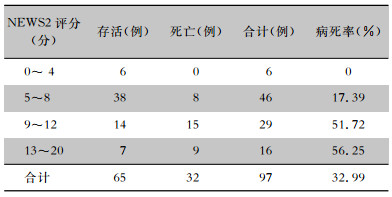
|
患者血乳酸水平主要集中低水平区间,血乳酸<2 mmol/L占64.95%,该评分区间病死率20.63%。患者病死率随血乳酸水平增高逐渐增高,在血乳酸≥6 mmol/L最高,达75.00%。见表 3。
| 表 3 不同血乳酸水平患者分布及病死率 Table 3 Distribution and mortality of patients with different blood lactic acid levels |
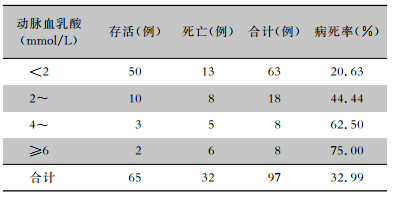
|
以随访28天死亡为因变量(赋值:是=1,否=0),纳入表 1单因素分析中P<0.05的指标,使用二元logistic回归分析筛选预测死亡风险的危险因素。结果表明,检测异常的动脉血乳酸、NEWS2评分及APACHE Ⅱ评分是SCAP患者28天死亡的独立危险因素(均P<0.05)。见表 4。
| 表 4 SCAP患者28天死亡的二元logistic回归分析 Table 4 Binary logistic regression analysis of 28-day mortality in SCAP patients |

|
常用的预后评估工具APACHE Ⅱ评分AUC为0.772(95%CI:0.676~0.851)。NEWS2评分、血乳酸的AUC分别是0.740(95%CI:0.640~0.824)、0.721(95%CI:0.630~0.815),均>0.7,对SCAP患者的预测价值良好,但二者间差异并无统计学意义(Z=0.299,P>0.05),分别与APACHE Ⅱ评分比较,差异也并无统计学意义(Z值分别为0.506、1.141,均P>0.05)。血乳酸+NEWS2评分二者联合预测SCAP患者的AUC为0.776(95%CI:0.680~0.855),高于APACHE Ⅱ评分(Z=0.063,P>0.05),预测效能最高。在预测SCAP患者28天死亡风险真实性方面,当血乳酸截断值为1.96时,灵敏度为68.7%,特异度为75.4%;当NEWS2评分截断值为7时,灵敏度为81.3%,特异度为63.1%;当APACHE Ⅱ评分截断值为20时,灵敏度为65.6%,特异度为83.1%;血乳酸+NEWS2评分二项联合检测时灵敏度为84.4%,特异度为70.8%。见表 5、图 2。
| 表 5 各危险因素预测SCAP患者28天预后的评估价值 Table 5 Evaluation value of risk factors in predicting the 28-day prognosis of SCAP patients |

|
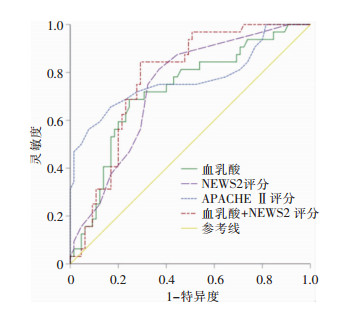 |
| 图 2 各危险因素预测SCAP患者28天死亡的ROC曲线 Figure 2 ROC curve for predicting 28-day mortality of SCAP patients by various risk factors |
CAP是脓毒症的主要来源,并且与脓毒症住院患者病死率相关[1, 13-14],SCAP是CAP的重症表现,起病凶猛,进展迅速,常合并脓毒性休克、多器官功能障碍综合征等并发症,病死率很高,从25%到50%不等[15]。本研究发现,SCAP患者28天病死率为32.99%,与文献[15]报道基本一致。CAP指南建议使用CURB-65评分进行风险评估,然而,任何评分系统仅辅助评价,需结合临床指标等综合判断[12],而且,有研究[16]表明CURB-65不是SCAP患者病死率预测的最佳工具。最新研究[5-6]表明更新后的NEWS2评分能预测急诊危重患者30天死亡风险,对脓毒症患者向重症监护病房(ICU)转移和短期死亡风险有良好预测价值[7],但在SCAP具体人群中罕有研究。脓毒症是SCAP的主要并发症,脓毒症患者的高乳酸血症(>2 mmol/L)与不良预后相关[17],提示血乳酸的测定可能是识别SCAP患者死亡风险增加的一种简单而有效的策略,然而,乳酸在CAP患者中的研究数据很少且意见尚未统一[15, 18]。因此,评估NEWS2评分联合血乳酸在预测SCAP患者28天预后价值方面很有意义。
本研究发现,首先,在使用多变量logistic回归分析调整混杂因素后,更新后的快速诊断量表NEWS2评分仍是SCAP患者28天死亡的独立危险因素;其次,入院初始动脉血乳酸具有与NEWS2评分相似的良好独立预测价值,若联合NEWS2评分则与公认的传统危重患者预后评分如APACHE Ⅱ评分有相似的预测价值;最后,对NEWS2评分及乳酸具体分层分析发现,患者病死率随NEWS2评分、动脉血乳酸水平增高逐渐增高,在NEWS2评分13~20分为最高,达56.25%,在乳酸≥6 mmol/L为最高,达75.00%。
APACHE Ⅱ评分在临床上被广泛用于评估危重患者的预后[13],然而,APACHE Ⅱ评分需要12个不同权重的变量,相对繁琐且使用不便。与之相比,NEWS2评分简便易算,仅基于6个生命体征变量,数分钟内床旁即可快速评分评估,此为其优势之一。与其他传统EWS评分系统相比,NEWS2评分的优势是其部分评分参数与低氧血症的程度有关,例如氧饱和度和氧气补充,故可以为低氧血症相关疾病如肺炎解释其相对更好的性能[8]。本研究表明,与存活组相比,死亡组NEWS2评分明显升高,并且是独立危险预测因素,NEWS2评分的AUC为0.740,具有中等强度的预测价值。本研究发现,与APACHE Ⅱ评分灵敏度(65.6%)、特异度(83.1%) 比较,NEWS2评分预测死亡风险具有高灵敏度(81.3%),中等特异度(63.1%),但与研究[5]结果NEWS2评分预测危重患者病死率灵敏度为(97.0%)、特异度(59.0%)比较,灵敏度偏低而特异度稍高。本研究还发现,其预测死亡风险最佳截点为7分,研究[5]表明NEWS2评分预测成人危重住院患者病死率的最佳截点为6.5分,并有研究[9, 19]认为NEWS2评分为7分或以上被认为是重症患者,需要紧急响应,本研究结论与其基本一致。
血乳酸是易检测、够便捷的床旁即时检验(POCT)项目之一。血乳酸是组织低灌注和细胞缺氧敏感性的指标,是器官衰竭的早期生物标志物,高乳酸水平是ICU脓毒症患者住院病死率的独立影响因素[13, 17]。但仍存有争议,最新国外研究[6]显示,高乳酸水平与急诊危重患者30天死亡风险无关,血乳酸不是CAP引起的脓毒症住院病死率的独立预测因子[14]。然而,本研究表明,入院初始血乳酸水平也是SCAP患者28天死亡的独立危险因素,并且AUC为0.721。本研究是少数几项强调血乳酸水平作为SCAP患者28天死亡率的预测指标的研究之一,与研究[18, 20]结论一致。并且,本研究提出的乳酸截断值为1.96 mmol/L,与预测CAP不良预后的截断值1.8 mmol/L[18]、脓毒症中已确定的截断值2 mmol/L[17]非常接近,超过截断值提示与更大死亡风险相关,这也提示临床工作中对于血乳酸水平≥1.96 mmol/L的患者,必须加强对急性脓毒性器官功能障碍的评估和复苏。
ROC曲线分析表明,NEWS2评分、乳酸的AUC均>0.7,预测效能不相上下,并且二者分别与APACHE Ⅱ评分比较差异无统计学意义(均P>0.05);对独立预测指标的数值进一步分区间分析发现,患者病死率随NEWS2评分、乳酸的增高而逐渐增高;同时进行相关性分析发现,床旁检测指标乳酸与简单评估工具NEWS2评分、复杂评估工具APACHE Ⅱ评分均具有较好的相关性(r值分别为0.411、0.709,均P<0.001),这些发现表明,NEWS2评分、乳酸对SCAP患者的28天死亡风险均具有较高的独立预测价值。NEWS2评分、乳酸床旁易得,因此,本研究绘制NEWS2评分、乳酸二者联合预测曲线,发现其AUC达0.776,较单一指标的AUC更高,高于复杂工具APACHE Ⅱ评分(AUC为0.772),且具有高灵敏度(84.4%)和高特异度(70.8%),高于简单工具NEWS2评分单独预测的灵敏度(81.3%)和特异度(63.1%),说明二者联合更有利于预测SCAP患者28天死亡风险,入院血乳酸可提高SCAP患者NEWS2评分的预后价值,而西班牙最新研究[5]显示乳酸可提高NEWS2评分对危重患者住院病死率的预测能力,本研究与之类似。本研究表明,NEWS2评分快速评估,同时联合床旁乳酸快速检测有助于SCAP患者的快速风险分层决策,从而早期预判病情、严密监测、强化管理。
最新研究[15, 21]表明,CD3+ CD4+T淋巴细胞计数、NLR与SCAP预后不良有关,但需要更多证据。因此,本研究也纳入并评估对SCAP患者28天死亡风险存在负面影响的预后因素,包括氧合指数、PCT、NLR、CD3+ CD4+T淋巴细胞计数,作为成人SCAP患者病死率可能的预测指标。本研究表明,与存活组相比,SCAP患者死亡组PCT、NLR明显升高,氧合指数、CD4+T淋巴细胞计数明显下降,但通过校正混杂因素,并未能够确定上述指标为独立危险因素,这种差异可能是由于患者选择差异造成。需要更多人群的未来研究证实这些结论。
本研究存在一些局限性。首先,这是对连续SCAP患者的回顾性单中心分析。提议的临界值需要独立和多中心研究队列的验证。其次,还需要一项前瞻性研究评估额外乳酸测量的临床益处。最后,需要进一步研究通过动态评估NEWS2评分及监测血乳酸找到最佳预测值。
总之,入院时NEWS2评分、高乳酸水平是SCAP患者28天死亡的独立危险因素,二者床旁易得,对SCAP患者28天死亡风险均具有较高的独立预测价值,NEWS2评分联合入院动脉血乳酸预测SCAP患者短期预后的价值更高,优于单个评分。
利益冲突:所有作者均声明不存在利益冲突。
| [1] |
Caraballo C, Ascuntar J, Hincapié C, et al. Association between site of infection and in-hospital mortality in patients with sepsis admitted to emergency departments of tertiary hospitals in Medellin, Colombia[J]. Rev Bras Ter Intensiva, 2019, 31(1): 47-56. |
| [2] |
Hamilton F, Arnold D, Baird A, et al. Early warning scores do not accurately predict mortality in sepsis: a Meta-analysis and systematic review of the literature[J]. J Infect, 2018, 76(3): 241-248. DOI:10.1016/j.jinf.2018.01.002 |
| [3] |
Royal College of Physicians. National Early Warning Score (NEWS) 2[EB/OL]. [2022-09-18]. https://www.rcplondon.ac.uk/projects/outputs/national-early-warning-score-news-2.
|
| [4] |
Baker KF, Hanrath AT, Schim van der Loeff I, et al. Natio-nal Early Warning Score 2(NEWS2) to identify inpatient COVID -19 deterioration: a retrospective analysis[J]. Clin Med (Lond), 2021, 21(2): 84-89. |
| [5] |
Durantez-Fernández C, Martín-Conty JL, Polonio-López B, et al. Lactate improves the predictive ability of the National Early Warning Score 2 in the emergency department[J]. Aust Crit Care, 2022, 35(6): 677-683. DOI:10.1016/j.aucc.2021.10.007 |
| [6] |
López-Izquierdo R, Martín-Rodríguez F, Santos Pastor JC, et al. Can capillary lactate improve early warning scores in emergency department? An observational, prospective, multicentre study[J]. Int J Clin Pract, 2021, 75(4): e13779. |
| [7] |
Hsu CY, Tsai YH, Lin CY, et al. Application of a 72 h National Early Warning Score and incorporation with sequential organ failure assessment for predicting sepsis outcomes and risk stratification in an intensive care unit: a derivation and validation cohort study[J]. J Pers Med, 2021, 11(9): 910. DOI:10.3390/jpm11090910 |
| [8] |
Zhang K, Zhang X, Ding WY, et al. The prognostic accuracy of National Early Warning Score 2 on predicting clinical deterio-ration for patients with COVID -19:a systematic review and Meta-analysis[J]. Front Med (Lausanne), 2021, 8: 699880. |
| [9] |
Peng LL, Luo Z, Liang LL, et al. Comparison of the perfor-mance of 24 early warning scores with the updated National Early Warning Score (NEWS2) for predicting unplanned intensive care unit (ICU) admission in postoperative brain tumor patients: a retrospective study at a single center[J]. Med Sci Monit, 2021, 27: e929168. |
| [10] |
Pimentel MAF, Redfern OC, Gerry S, et al. A comparison of the ability of the National Early Warning Score and the National Early Warning Score 2 to identify patients at risk of in-hospital mortality: a multi-centre database study[J]. Resuscitation, 2019, 134: 147-156. DOI:10.1016/j.resuscitation.2018.09.026 |
| [11] |
李鸿茹, 林晓红, 林丹, 等. 重症社区获得性肺炎患者预后危险因素分析[J]. 中国呼吸与危重监护杂志, 2018, 17(5): 450-455. Li HR, Lin XH, Lin D, et al. Prognosis analysis of severe community-acquired pneumonia[J]. Chinese Journal of Respiratory and Critical Care Medicine, 2018, 17(5): 450-455. |
| [12] |
中华医学会呼吸病学分会. 中国成人社区获得性肺炎诊断和治疗指南(2016年版)[J]. 中华结核和呼吸杂志, 2016, 39(4): 253-279. Chinese Society of Respiratory Diseases. Guidelines for diagnosis and treatment of adult community-acquired pneumonia in China(Version 2016)[J]. Chinese Journal of Tuberculosis and Respiratory Diseases, 2016, 39(4): 253-279. |
| [13] |
Cao LH, Xiao M, Wan Y, et al. Epidemiology and mortality of sepsis in intensive care units in prefecture-level cities in Sichuan, China: a prospective multicenter study[J]. Med Sci Monit, 2021, 27: e932227. |
| [14] |
Mendoza D, Ascuntar J, Rosero O, et al. Improving the diagnosis and prognosis of sepsis according to the sources of infection[J]. Emerg Med J, 2022, 39(4): 279-283. DOI:10.1136/emermed-2021-211910 |
| [15] |
Cillóniz C, Dominedò C, Garcia-Vidal C, et al. Community-acquired pneumonia as an emergency condition[J]. Curr Opin Crit Care, 2018, 24(6): 531-539. DOI:10.1097/MCC.0000000000000550 |
| [16] |
Zhu YL, Zheng XB, Huang KZ, et al. Mortality prediction using clinical and laboratory features in elderly patients with severe community-acquired pneumonia[J]. Ann Palliat Med, 2021, 10(10): 10913-10921. DOI:10.21037/apm-21-2537 |
| [17] |
Shankar-Hari M, Phillips GS, Levy ML, et al. Developing a new definition and assessing new clinical criteria for septic shock: for the third international consensus definitions for sepsis and septic shock (sepsis-3)[J]. JAMA, 2016, 315(8): 775-787. DOI:10.1001/jama.2016.0289 |
| [18] |
Frenzen FS, Kutschan U, Meiswinkel N, et al. Admission lactate predicts poor prognosis independently of the CRB/CURB-65 scores in community-acquired pneumonia[J]. Clin Microbiol Infect, 2018, 24(3): 306.e1-306.e6. DOI:10.1016/j.cmi.2017.07.007 |
| [19] |
Pullyblank A, Tavaré A, Little H, et al. Implementation of the National Early Warning Score in patients with suspicion of sepsis: evaluation of a system-wide quality improvement project[J]. Br J Gen Pract, 2020, 70(695): e381-e388. DOI:10.3399/bjgp20X709349 |
| [20] |
Zhou HJ, Lan TF, Guo SB. Stratified and prognostic value of admission lactate and severity scores in patients with community-acquired pneumonia in emergency department: a single-center retrospective cohort study[J]. Medicine (Baltimore), 2019, 98(41): e17479. DOI:10.1097/MD.0000000000017479 |
| [21] |
梁欢, 高烨, 苗常青, 等. 中性粒细胞/淋巴细胞比值对重症肺炎患者28 d死亡风险的预测价值[J]. 中华危重病急救医学, 2019, 31(7): 827-831. Liang H, Gao Y, Miao CQ, et al. Predictive value of neutrophil to lymphocyte ratio on 28-day mortality of patients with severe pneumonia[J]. Chinese Critical Care Medicine, 2019, 31(7): 827-831. |



